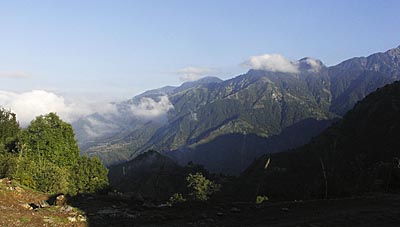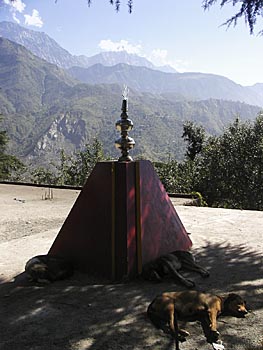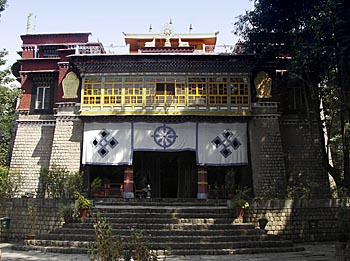
The settlement of McLeod Ganj rises to an altitude of 1,800 meters, extends along a pine-covered ridge with valley views below and the near vertical walls of the Dhauladhar range towering behind. Despite being named after David McLeod, the Lieutenant Governor of Punjab when the hill station was founded in 1848, little evidence of British occupation remains.

Today Indian residents are outnumbered by Tibetans, for who 15,000 now call it home, with thousands of refugees still fleeing Chinese oppression every year. McLeod Ganj is not simply a political haven for Tibetans but is also home to Tibetan spiritual leader, His Holiness the XIV Dalai Lama, and to the Tibetan government in exile since 1959/60. And as equally important it is at the heart of the struggle to keep Tibetan culture, language and religion alive.
Streams of Tibetan refugees from all over the world flock to McLeod Ganj to receive blessings and teachings from His Holiness the Dalai Lama. Western and Indian tourists and scholars come here to see the rebirth of an ancient and fascinating civilization. The high altitude and cool weather contribute physically to this recreation of the original Tibetan environment. Dharamsala pulsates with the sights and sounds of old Tibet. Though certainly more modern, life is basically Tibetan in character. Shops strung out along the narrow streets of McLeod Ganj sell traditional Tibetan arts and handicrafts and the aroma of Tibetan dishes lingers in the air.
Over 130,000 Tibetans live in exile in India, Nepal, Bhutan, and other countries around the world. The majority currently live in India, with 20% in Nepal and the remaining 5% in Bhutan and other countries such as Switzerland and the US. While they are now free to practice their religion and rebuild their cultural heritage, they face many challenges as newcomers in Tibet's neighboring countries, especially in India.

Many exiles endured the treacherous conditions of the Himalayan mountains to escape the oppression of the Chinese Government and arrive in India and Nepal with little to support themselves and minimal education. This steady stream of newly arrived refugees depend upon existing projects and programs supported by government offices and NGOs in exile for education and basic sustenance.
Led by H.H. The Dalai Lama, the Tibetan Government in Exile faces the formidable task of raising awareness of its country's situation and exerting what little diplomatic pressure they have to improve conditions for their people in Tibet while also creating programs to sustain and develop Tibetan settlements.
Education for Tibetans has been a high priority for the government in exile. Primary education schools (called Tibetan Children's Villages) were quickly set up by the Dalai Lama's sister soon after going into exile, and many more were soon to follow. Currently, there are a host of different schools catering to all ages of Tibetan children, including special institutions to educate and support newly arrived refugees.
A wide range of non-profit organizations have been established over the years that have evolved to meet the growing needs of the Tibetan communities. The Tibet Woman's Association draws attention to women's issues in Tibet and their own communities, the Tibetan Center for Human Rights and Democracy monitors human rights violations in Tibet and publishes reports to raise awareness about the conditions of Chinese occupation, the Tibet Welfare Office promotes the general welfare of residents in Tibetan communities and oversees various environmental programs, and many new schools have developed to teach language instruction and computer classes to those that wish to continue their education.

The mass exile of the Tibetan people has also resulted in the construction of many new monasteries and nunneries to preserve the monastic tradition of Tibetan Buddhism. These institutions support religious practitioners in their studies and provide schooling in not only Buddhist philosophy and practice but also for other topics such as English and computers.